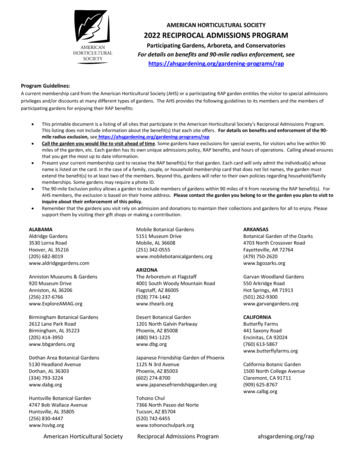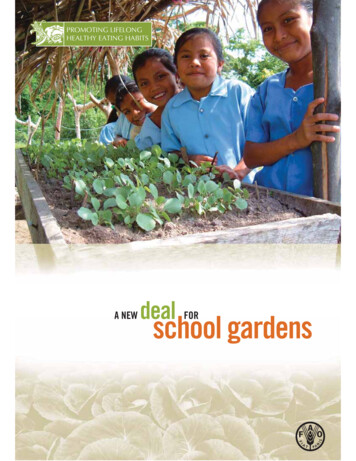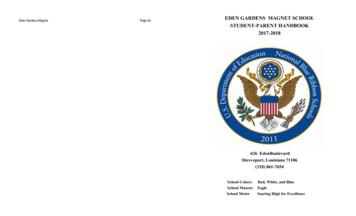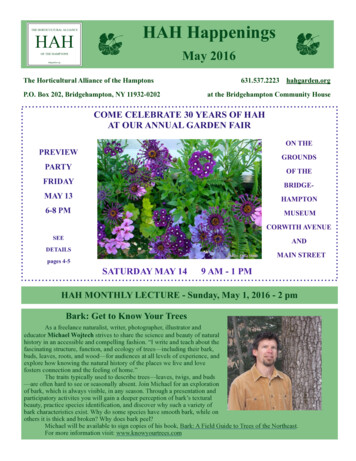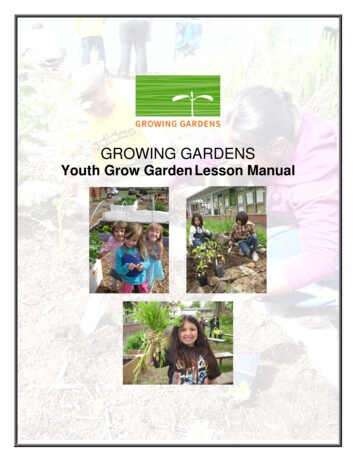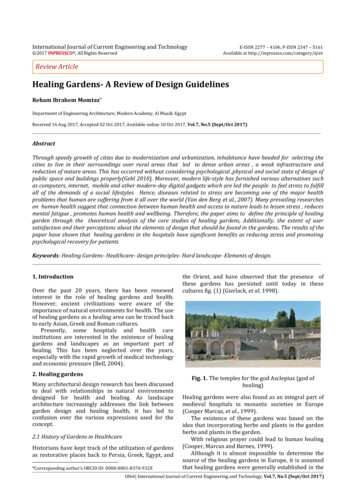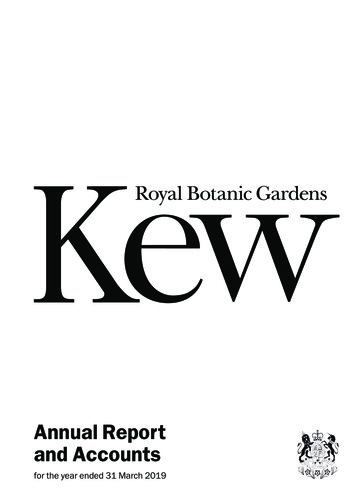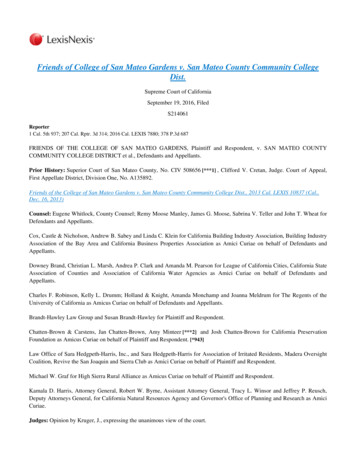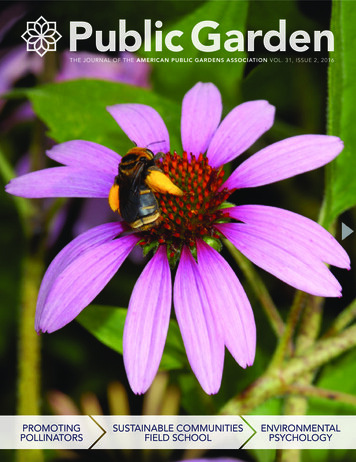
Transcription
Public GardenTHE JOURNAL OF THE AMERICAN PUBLIC GARDENS ASSOCIATION VOL. 31, ISSUE 2, 2016PROMOTINGPOLLINATORSSUSTAINABLE COMMUNITIESFIELD SCHOOLENVIRONMENTALPSYCHOLOGY
We told our engineers it wasimpossible to make ACRYLITE Acrylic glazing stronger. they disagreed.New and Improved ACRYLITE High ImpactAcrylic glazing now provides twice theprotection for your valuable greenhouse crops.For decades, leading growers have relied on the strengthand weatherability of ACRYLITE high impact acrylicmulti-skin sheets to provide long-term growth results.Now, with double the impact strength of our previousgeneration, our new, more robust acrylic sheet provideseven more protection from hail. You can now expect evenhigher performance and protection from the industry’smost weatherable greenhouse covering.Backed by our new and improved 30-year non-yellowing& 10-year non-prorated hail & light transmissionwarranty, building new or recovering with ACRYLITE high impact acrylic is a choice you’ll be glad you madefor decades to come.Test it for yourself. Call us at 905-984-1598 or visitacrylitebuildingproducts.com and we’ll ship you samplesof our new products free of charge.Available spring of 2016.
ROUGHCONSERVATORIESC L E A R LY S U P E R I O RThe Rough tradition of excellencecontinues at the United StatesBotanical Gardens.Since 1932 Rough has been buildingand maintaining large, high-qualityglazed structures, including: arboretums botanical gardens conservatoriesWe have the experience, resources,and technical expertise to solve yourdesign needs. For more informationabout Rough Brothers’ products andservices, call 1-800-543-7351, or visitour website: www. roughbros.comDESIGN SERVICESMANUFACTURINGSYSTEMS INTEGRATIONCONSTRUCTION5513 Vine StreetCincinnati OH 45217ph: 800 RISKCreating Landscapes that Teach, Inspire and Succeed.AT IYEN G 10ALERS!CEBRAs we celebrate our ten-year milestone, Terra Design Studiosremains unwavering in our dedication to create landscapes thatteach, inspire and succeed.Yet we have not journeyed through the last decade alone.You, our colleagues and friends, have offered your wisdom, strength andpassion every step of the way, and for that, we thank you!INSURANCE andRISK MANAGEMENTF O RP U B L I CG A R D E N SWe eagerly look towards the future,and hope you will continue to join us for the ride!Sharon Van Loon, CPCUCindy Tyler, PrincipalKim Slager CRM, CICwww.terradesignstudios.com1.800.350.7676 bhsins.comkslager@bhsins.com!RSBRAT IYEN G 10AAAT IYEN G 10LELERS!CECEBRsvanloon@bhsins.com
Public Garden Leadership Fellows ProgramTake your career to the next level!Enroll in Cornell University’s one-year Public GardenLeadership Fellows master’s degree program.Visitcornellplantations.org/PGL
THE JOURNAL OF THE AMERICAN PUBLIC GARDENS ASSOCIATION VOL. 31, ISSUE 2, 2016CONTENTSFOCAL POINTS6Promoting Pollinators at Powell Gardens Powell Gardens is conserving pollinators, along with their habitats and host plants,and educating the public about their usefulness to life and well-being.8 Sustainable Communities Field School At the University of British Columbia, this school teaches local business employeesto care for the environment by engaging them in activities throughout the garden.18 Nature: Life’s Best Medicine Research proves what we in the public garden world have always known—being ingreen spaces is good for you. How can we communicate that more effectively?20 Making a Place Ours By learning what your garden means to your visitors and supporters, you can bettercraft a message that resonates with all.26 Administrative Lessons A recently retired director shares lessons learned over his twenty-eight-year career.BACKBONES121428Multi-Disciplinary: The Southwest Experimental Garden ArraySmall Garden, Big Impact: Cornell Plantations’ Climate Change GardenHorticultural How-To: Tree Management and Climate ChangePERENNIALS5 Executive Director’s Note16 Photosynthesis22 How Does Your Garden Grow?24 Garden Professional Spotlight25 Garden Exhibition: The Alcatraz Floralegium27 T hings We Love This Spring30 Nationally Accredited Plant Collection Showcase
MANAGING EDITORDorothea J. Coleman American Public Gardens AssociationEDITORIAL ADVISORY GROUPShari Edelson The Arboretum at Penn State UniversityCarissa Kowalski Dougherty The Morton ArboretumJenny Young DuPont Garden ConservancyErin Grajek Buffalo and Erie County Botanical GardensJ. Eric Jackson Powell GardensSharon Loving Longwood GardensTracy Magellan Montgomery Botanical CenterDon Rakow, Chair Cornell UniversityAndy Sell University of MichiganMelanie Sifton Brooklyn Botanic GardenCaitlin Simkovich American Public Gardens AssociationOn the Cover:Svastra obliqua, a sunflower bee, is a large,solitary, ground-nesting bee. To best meet the bee'sneeds plant members of the Aster family, especiallysunflowers, and leave some patches of bare,undisturbed ground in which it can nest. Unlike mostground-nesters, females may nest separately, orseveral may share a single opening.Photo: Betsy BetrosDESIGNER: Alena McCullough VisionaeriePRINTER: SheridanEDITORIAL CONSULTANT: Gail Brodhead-Kae GBK Research, LLCAMERICAN PUBLIC GARDENS ASSOCIATION BOARD OF DIRECTORSPRESIDENT — Sabina Carr Atlanta Botanical GardenVICE PRESIDENT — William M. LeFevre Sarah P. Duke GardensTREASURER — Kara Newport Daniel Stowe Botanical GardenSECRETARY — Ray Mims United States Botanic GardenIMMEDIATE PAST PRESIDENT — Kenneth J. Schutz Desert Botanical GardenDIRECTORS AT LARGEGrace E. Chapman Lewis Ginter Botanical GardenCarmia Feldman University of California Davis Arboretum and Public GardenM. Patrick Griffith Montgomery Botanical CenterPaul Kuenstner Fidelity FoundationJane O. MacLeod Cheekwood Botanical Garden & Museum of ArtMark Runciman Royal Botanical GardensShane D. Smith Cheyenne Botanic GardensSharon VanLoon Berends Hendricks Stuit InsuranceBrian Vogt Denver Botanic GardensEX OFFICIOScott LaFleur Sherman Library and GardensD. Casey Sclar Executive Director, American Public Gardens AssociationAMERICAN PUBLIC GARDENS ASSOCIATION351 Longwood Road, Kennett Square, PA 19348Phone: 610-708-3011 Fax: 610-444-3594www.publicgardens.orgADVERTISERS(In alphabetical order)BHS INSURANCE. 1CORNELL UNIVERSITY/CORNELL PLANTATIONS. 2COUNTRY CASUAL TEAK. 32EVONIK INDUSTRIES. Front Inside CoverLONGSHADOW. Back CoverOASIS DESIGN GROUP. 23ORIGAMI IN THE GARDEN. 2RIBBIT EXHIBIT. Back Inside CoverVolume 31, Issue 2, 2016. Public Garden (ISSN 0885- 3894) is published quarterly by the American Public Gardens Association,351 Longwood Road, Kennett Square, PA 19348. 2016, American Public Gardens Association. All rights reserved. Public Gardenis self-indexed at http://publicgardens.org/past-issues. Opinions expressed by contributors are not necessarily those of AmericanPublic Gardens Association. Public Garden welcomes editorial submissions but assumes no responsibility for the loss or damage ofunsolicited material. American Public Gardens Association serves North American public gardens and horticultural organizations bypromoting professional development through its publications and meetings; advocating the interests of public gardens in political,corporate, foundation, and community arenas; and encouraging gardens to adhere to professional standards in their programsand operations.SUBSCRIPTIONS All members of the American Public Gardens Association receive a free subscription to the magazine. Subscriptionsare available to firms and individuals interested in working with members of the garden industry as follows: in the US at 48 per year;all others at 90 per year (includes a postage and handling charge).CHANGE OF ADDRESS Send new address, zip code, moving date, and old address label to American Public Gardens Association,351 Longwood Road, Kennett Square, PA 19348.ADVERTISERS For information about advertising, contact Jessie Keith, Member Engagement and Program Assistant, 610-708-3010 orjkeith@publicgardens.org. Or request a media kit at PublicGardenMag@publicgardens.org.ROUGH CONSERVATORIES. 1STUDIO OUTSIDE. Back Inside CoverTERRA DESIGN STUDIOS. 1[4, 5]
Greetings, Public Garden Readers,Public gardens have never been more essential. Our gardens decidedly engage the public, locally andglobally, through pioneering programs and advocacy. Engaging service and powerful messaging allow us totruly connect our communities, improving quality of life for all.Public Garden is your voice. Newly refreshed, the journal allows us to share our best—serving as a force toempower all we do. This issue is abundant with exciting, innovative programs and collaborations thatshow how we protect, connect, and champion through research, education, and the promotion of bestpractices in the world of public horticulture.The Association’s Climate & Sustainability Alliance connects public garden educators and other professionals with curricula and resources designed to address the challenges of communicating climate change andsustainability to diverse audiences. Several articles in this issue, such as the Southwest ExperimentalGarden Array (SEGA) (page 12), Cornell University’s Climate Change Garden (page 14), and SustainableCommunities Field School (page 8), Powell Gardens’ local initiatives to celebrate and protect pollinators(page 6), and the tree management program at Longwood Gardens (page 28), show how gardens of allsizes have something to contribute.Our Association will continue to provide you with the resources needed on critical issues such as plantconservation, biodiversity, and the science of climate change. Promoting leadership-level programs andbest practices strengthens our gardens and promotes community resilience. Public Garden connects ourindustry. When member institutions and partners share information through it, our readers are inspiredto preserve and celebrate the world of plants, creatively and sustainably.Our vision is a world where public gardens are indispensable. The refreshed Public Garden continues its serviceas the journal of public horticulture. Your Association can showcase its best by sharing your best.Yours,D. Casey SclarExecutive DirectorAmerican Public Gardens AssociationPUBLIC GARDEN Vol. 31, ISSUE 2, 2016Back to Table of Contents
PROMOTINGPOLLINATORSAT POWELLGARDENSAlan Branhagenphotos: Betsy BetrosTree City USA is now being challenged by Bee City USA—an urban forest can nolonger consist of lifeless zelkovas, London planes, and ginkgos; the trees mustprovide for the birds and the bees! A landscape of low-maintenance, pest-free,sterile, “no mess” plants, once so in vogue, has now revealed its true cost to ahealthy environment. We need nature for its ecosystem services. Americanecologist, forester, environmentalist, and nature writer Aldo Leopold’s openingstatement in his 1949 classic A Sand County Almanac: And Sketches Here andThere— “There are those who can live without wild things and those whocannot”—has been updated by entomologist and wildlife ecologist Doug Tallamy,“If you think you can live without wild things, you should know that you cannot.”One mouthful of food out of three is provided by the work of pollinators.Pollinators support billions of dollars in agriculture production. While honeybeesare good pollinators (and produce honey) and are widely utilized across thecountry, research shows that many of our native bees, wasps, beetles, and flies arejust as good, and many are much better pollinators.The alarming decline of the beloved (non-native) honeybee instigated a publicoutcry and led the conversation into the importance of pollinators in oureveryday landscapes. Recent population crashes of the iconic monarch have alsocaught the public’s attention. The plight of lesser-known, once-abundant insectssuch as the regal fritillary (Speyeria idalia) and American bumblebee (Bombuspensylvanicus) still goes largely unreported by the mainstream press.In response, gardening, landscape design, landscape management, and naturalarea protection and conservation have been reinvigorated by a new call to action.The gardening-with-a-purpose Millennials are inspired by this evolution ofenvironmentally responsible gardening style. The implications of this can be feltat Powell Gardens, Kansas City, and across our Lower Midwest region.Our Heartland Harvest Garden was designed with integrated “insectaries,”gardens that attract pollinators and beneficial insects and act as traps for pests.Overall, Powell Gardens has adopted a more natural style, integrating nativeplants throughout, and providing a reservoir of pollinators and other beneficialinsects. We must keep managing all the plants in our care wisely, whether in the[6, 7]
The Million Pollinator Garden Challenge was launched by The National PollinatorGarden Network (NPGN), a collaboration of horticulture business, garden, pollinator, and conservation community stakeholders working together to support thehealth of pollinating animals. Eight founding, private, nonprofit members convened in fall 2014 to propose public/private sector efforts to help restore criticalpollinator populations in support of the President’s National Strategy to “Promotethe Health of Honey Bees and Other Pollinators.” Everyone can answer this call to action to preserve andcreate gardens and landscapes that help revive the health of bees, butterflies, birds, bats, and other pollinators across the country. We willmove millions of individuals, kids, and families outdoors and make aconnection between pollinators and the healthy food people eat.greenhouse or in the garden and surrounding landscape,so that our populations of pollinators remain healthyand diverse. As we do, our pest control budget willcontinue to decline.To bring the public’s attention to these important insects,Powell Gardens has celebrated pollinator week annually forfive years. Our Festival of Butterflies—the highest attendedsuch festival in the country—celebrates our great diversity ofon-site insects and butterflies. It owes its success to ourcollaboration with locally based Monarch Watch, JohnsonCounty; Kansas Extension Master Gardeners; MissouriMaster Naturalists; and the Idalia Society.Powell Gardens is partnering with Kansas City ands),an umbrella group of organizations (both governmentand non-government) whose mission is to help restore andmanage the region’s finest natural areas, the requisitereservoirs of pollinator diversity. Kansas City Wildlands hasconducted a bioblitz at Powell Gardens’ 970-acre parcel, mostof which is wild, and helped with prescribed fires on ourtwenty acres of remnant prairies. Each fall they bring us seedcollected from native habitat, and we grow it to seedling plugsfor restoration work the following season. We must not forgetthat many native plants, such as spring beauty, pale purpleconeflower, wild geranium, and Pitcher sage, have additionalunique, host-specific pollinators, so pollinator conservation isrequired beyond gardens.Powell Gardens is a founding member of Grow Native!(www.grownative.org), a program started by the Missourifar left: Macrosiagon limbata male on amint – the larvae of this species ofwedge-shaped beetles attaches itself to awasp and is carried back to the wasp’s nest,where it will then parasitize a wasp larva.The males sport feathery antennae.left: Trichopoda spp.– tachinid flies are notonly good pollinators, but their larvae areparasites of true bugs, including squash bugs.right: All Aetole moths hold their hindlegsaloft while perched. The unrelated mothcaterpillars are inchworms, Eupithecia spp.Department of Conservation to promote native Missouriplants. It now falls under the non-profit Missouri PrairieFoundation (www.moprairie.org). The Grow Native! programpromotes native plants across the Lower Midwest, fromeastern Kansas to southern Illinois. Debuting this year isGrow Native!’s Pollinator Buffet program which promotes adozen of the best native plants for attracting native bees.Grow Native! member-retailers can buy the beautifullydesigned and information-rich Pollinator Buffet plant tags tohighlight these plants. This program adds to the popularMonarch Cafe plant tags which promote the sale of garden-worthy milkweeds. It’s a model way to get consumers topurchase pollinator-friendly plants and integrate them intoany landscape.Last, a new organization, the Kansas City Native PlantInitiative, is joining forces with us to promote the use ofnative plants and environmentally conscious landscapes,a sure sign that the honeybee and monarch are leadingus to a more pollinator-friendly, healthier community.Alan Branhagen has been Director of Horticulture atPowell Gardens since 1996. He holds BS and MLA degreesbut considers himself an all-around plantsman and naturalist. His bookNative Plants of the Midwest by Timber Press is due out this fall.Betsy Boutros, our local Idalia Society “Bug Lady,” regularly volunteersat Powell Gardens and has been documenting the pollinators on our site.She has contributed 1,840 images to BugGuide (www.bugguide.net)—a valuable citizen science resource. She is also the author ofA Photographic Field Guide to the Butterflies of the Kansas City Region.PUBLIC GARDEN Vol. 31, ISSUE 2, 2016Back to Table of Contents
Valuable Resourcesfor Public Garden ProfessionalsAt the intersection of nature, culture, and community, publicgardens are uniquely positioned to lead the transition to asustainable future. Gardens can develop strategies and adoptpractices that integrate sustainability components to increasesustainability within their gardens, and beyond throughexample, education, and outreach. As we recognize that peopleand culture are part of, not separate from the environment, wesee that true sustainability is a dynamic system of three equallycritical components: (1) environmental, (2) social (people), and(3) economic. Developing and adopting a comprehensivesustainability strategy that integrates all three is the mosteffective way to introduce or advance sustainability. Recentlyupdated and in peer review, the Public Garden SustainabilityIndex establishes sector-wide sustainability standards and offersunique tools to help public gardens reduce climate impacts.Public gardens have a unique credibility in the eyes of thepublic. As important centers of conservation and formal andinformal science education, public gardens serve as a majorsource of climate change and sustainability information forvisitors and students of all ages and skill levels. The Climate &Sustainability Alliance connects public garden educators andother professionals with curriculum designed to address thechallenges of communicating climate change to diverseaudiences. The American Public Gardens Association continuesto seek funding through collaborations with member gardensto address climate impacts by increasing the public’s ecologicalliteracy. A National Oceanic and Atmospheric Administration(NOAA) partnership provides public garden professionals withopportunities to exchange information on the impacts ofclimate variability and change, while utilizing the most currentclimate data.SUSTAINABLECOMMUNITIESFIELD SCHOOL:A GREENBUSINESSPROGRAMFOR GARDENSDavid Geselbracht and Patrick Lewisphotos: University of British ColumbiaClimate change poses an existential threat to the flora andecosystems public gardens showcase and conserve. TheAmerican Public Gardens Association is committed to providingits members with the resources and platform needed to pursuesound public policy on critical issues such as plant conservation,biodiversity, and the science of climate change.To get involved with these initiatives, contact Sarah Beck,Program Manager, Current and Future Initiatives, atsbeck@publicgardens.org.[8, 9]
BEES DANCE IN THE AIR ABOVE A GROUP OF HIVES AT THE EDGE OF UBC BOTANICAL GARDEN’S CAROLINIAN FOREST GARDEN. THE BEESPERFORM AN INTRICATE CHOREOGRAPHY, SEARCHING FOR FOOD AND PERFORMING THEIR TASKS, ALL PART OF A STORY ABOUT SUSTAINABILITY, COMMUNITIES, AND BIODIVERSITY. AROUND THE HIVES ARE EMPLOYEES FROM VISITING VANCOUVER BUSINESSES WHOARE BEING GUIDED BY DR. TARA MOREAU, ASSOCIATE DIRECTOR, SUSTAINABILITY AND COMMUNITY PROGRAMS. HER AUDIENCE AREPARTICIPANTS IN THE PILOT PHASE OF THE UBC SUSTAINABLE COMMUNITIES FIELD SCHOOL.CONDUCTED BY THE GARDEN IN COLLABORATION WITH VANCOUVER’S SOCIETY PROMOTING ENVIRONMENTAL CONSERVATION(SPEC), AND THE UNIVERSITY’S DEPARTMENT OF PSYCHOLOGY, THE FIELD SCHOOL WAS LAUNCHED IN SUMMER 2015. ITS CURRICULUM IS DESIGNED TO INCREASE UNDERSTANDING OF BIODIVERSITY, CLIMATE CHANGE, AND THE ROLE INDIVIDUALS CAN PLAY WITHINTHE SUSTAINABILITY MOVEMENT. THE FIELD SCHOOL USES TEAM-BUILDING EXERCISES AND EMPLOYEE-ENGAGEMENT ACTIVITIES TOBUILD SUPPORT FOR ACTION WITHIN THE CORPORATE ENVIRONMENT. TARGETING EMPLOYEES FROM TECH STARTUPS, ACCOUNTINGFIRMS, AND LOCAL BANKS, MOREAU HOPES TO SPARK A CONVERSATION THAT WILL REVERBERATE THROUGHOUT THE COMMUNITY.GREENING BUSINESSMoreau has worked as a consultant for the United NationsFood and Agricultural Organization (FAO) and as a post-doctoral research fellow with the Pacific Institute for ClimateSolutions. She is well aware of the discussions that take placewithin universities and the offices of non-governmentalorganizations, and of the sometimes insular nature of thosediscussions. As a scientist and activist, Moreau wants to engagethe business community, believing businesses must be onboard to help facilitate the changes we need in the face of risingCO2 emissions, ocean acidification, and the loss of forests, cleanwater, and species.“We need to create a green economy,” says Moreau. “But to dothat we need to work with business, meet them where they are,and engage them in a supportive sustainability dialogue.”At the global level, UN agencies and member governments areworking to explore and develop an inclusive green economy.According to the United Nations Environment Programme:“[a] green economy is one thatresults in improved humanwell-being and social equity,while significantly reducingenvironmental risks andecological scarcities.”But if the goal in Vancouver is to think globally and act locally,then it is important to get Vancouver businesses thinkingabout the key issues of our time such as water conservation,energy efficiency, and food security. One such business, VancityCredit Union, visited the Field School in July 2015 with newlyhired employees. The Credit Union, which already implementscarbon neutral programs and supports local environmentalinitiatives, wanted its new employees exposed to furthersustainability education.far left: Dr, Tara Moreauwelcomes participants to theSustainable CommunitiesField School.this page: While field schoolparticipants traverse theGreenheart TreeWalk, theylearn about the various layerswithin a forest and the role treesplay in water conservation.PUBLIC GARDEN Vol. 31, ISSUE 2, 2016Back to Table of Contents
Central to the Field School’s teaching is the GreenheartTreeWalk, a nine-hundred-foot-long cable bridge designed toallow visitors to experience a temperate rainforest canopy withminimal impact on trees and surrounding ecosystems. Thedesign and engineering of the TreeWalk uses “kissing bar”stabilizers that gently hug the trees and ride on the barkwithout penetrating or damaging the trees. As the Vancity staffexplored the shaded canopies of grand firs, Douglas firs, andthick cedars, Oliver Lane, Executive Director of SPEC, usedsimple props (an umbrella, sponge, and a coffee filter) toexplain issues facing local watersheds. Lane described howforests like the one they were in help to filter water and regulatewater cycles. He also explained how urbanization and climatechange drastically alter these natural processes. The severewater restrictions in Vancouver during the summer of 2015which led to critical water shortages and regional bans onnon-essential water use brought the topic into sharp focus.WHY A FIELD SCHOOL?Field schools are schools without walls where learners use all oftheir senses to engage with the surrounding environment. Theidea for the UBC Botanical Garden Sustainable CommunitiesField School was borrowed, in part, from work in South EastAsia in the 1990s, where UN-FAO Farmer Field Schools helpedsmall-scale farmers reduce pesticide use. Moreau, as part of herpostdoctoral research, took the UN-FAO concept and workedwith SPEC to adapt it to create Vancouver’s Urban Farmer FieldSchool (UFFS) in 2012.“The learning was woventhroughout the whole day, withoutyou realizing you had learned newthings,” she said. “And it wasn’ta classroom setting;people got to move their bodiesand smell the trees. It fed the soulas much as the brain.”Following the walk and hands-on activities, Hormus Karat, asenior branch manager at Vancity, explained the importance ofthe experience to the company and its employees. “Businesseswill have success in the long term when they understand, assist,and support a viable co-existence between people, businesses,precious natural resources, and our ecosystem,” he said.left: VanCity Credit Union staff participate in a water sharing activity.center: Participants learn about Zero Waste and how recyclingand composting play a part in achieving that goal.right: During a team-building exercise participants reflect on whatthey have learned.– Diane Collis, Food and Education Directorat the Greater Vancouver Food BankUFFS gave Moreau an opportunity to see how people respondto the different stimuli provided by an urban field school. Calmand relaxed interaction away from daily concerns could movediscussions about plants and soils to deeper inquiries aboutfood systems and climate change. Focusing on a fun andinteractive atmosphere seemed to provide safe and supportiveconditions for public engagement with larger, global issues. Theworkshops were often framed within the context of hands-onactivities about growing food plants and underlying gardeningissues, like composting and water use.[10, 11]
“People don’t want to hear a gloomy talk about climate change.But if they can prune fruit trees, grow food, and tend a garden,then it’s easier to talk about and consider these things.”In the winter of 2013-14, UBC Botanical Garden put itseducation programs temporarily on hold as it reassessed itsprogramming in light of the Garden’s evolving vision. WhenMoreau joined the Garden in the spring of 2014 she was giventhe opportunity to shape a new educational program: herprevious experience and the ambitions of a clear-sighted donormade the Field School a center-piece of the new initiatives.UNDERSTANDING THE IMPACT OF EDUCATION PROGRAMSThe goals of the Convention on Biological Diversity (CBD)include the objective of improving the public’s “educationand awareness about plant diversity, its role in sustainablelivelihoods, and importance to all life on Earth” (CBDSecretariat, 2015). Gardens are beautiful environmentswith a strong community presence that uniquely positionsthem to engage visitors in learning about biodiversity, climatechange solutions, and the international policies that affectthose issues. They can provide a range of initiatives withincontrolled and well-maintained environments that, whenproperly planned, allow for a variety of approaches tocomplex social and environmental questions.“It was interesting to learnabout the red alders and howthey are sometimes the firsttrees to come out after a fire,to reestablish the ecosystem”– Tarrynea Biallecki, bakery workerat Whole Foods in Vancouver.In 2016, UBC Botanical Garden is exploring its past, present, and future as itcelebrates its 100th year of operation. The Garden’s first director, JohnDavidson, was a man before his time. As the first provincial botanist, heestablished the UBC Herbarium, UBC Botanical Garden, and NatureVancouver. He promoted what would now be called “citizen science” in theearly part of the last century, and was a key advocate of raising awareness ofthe impacts of logging on local watersheds.The challenge to the Field School model is the challenge facedby all programs that seek to educate and activate: does it makea difference? Some recent research has presented that indeed,informal education at botanic gardens can positively affect theenvironmental attitudes of visitors, but quantitative evidencedemonstrating or describing these outcomes is rare. So Moreauand her team have reached out to University partners tomeasure the effects of the Field School on participant behavior.Psychologist Dr. Jiaying Zhao, a Canada Research Chair inbehavioral sustainability, and her interdisciplinary team fromUBC Psychology and the Institute for Resources, Environmentand Sustainability, collect data from the Field School, feedingthe information back to the program with the goal of improving outcomes.Moreau’s hope is that, when properly tested and verified, “themodel could be used and replicated in other communities toengage audiences on their own local sustainability issues.”David Geselbracht is a Vancouver based freelance journalist.He received a Master of Journalism from the University of British Columbiaand a BA Honours from the University of Victoria.Patrick Lewis has been director of UBC Botanical Garden since the fall of 2009.An administrator, his previous appointments have included Managing Directorof the UBC Centre for Applied Ethics as well as numerous non-partisangovernment inquiries. He has published both short fiction and non-fiction.PUBLIC GARDEN Vol. 31, ISSUE 2, 2016Back to Table of Contents
THE SOUTHWESTEXPERIMENTALGARDEN ARRAY:A TOOL FOR EXAMINING PLANTRESPONSES TO CLIMATE CHANGEIn
CONTENTS THE JOURNAL OF THE AMERICAN PUBLIC GARDENS ASSOCIATION VOL. 31, ISSUE 2, 2016 12 MuliDicilinar The Southwest Experimental Garden Array 14 Sall Garden Bi Iac Cornell Plantations' Climate Change Garden 28 Hriculural HT Tree Management and Climate Change BACKBONES 5 Executive Director's Note 16 Photosynthesis 22 How Does Your Garden Grow 24 Garden Professional Spotlight
